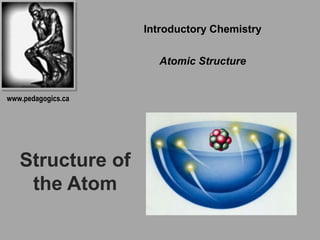
Chemistry 1 - Atomic Structure
- 1. Structure of the Atom Introductory Chemistry Atomic Structure www.pedagogics.ca
- 2. Atoms are tiny particles!! NUCLEUS ELECTRONS PROTONS NEUTRONS POSITIVE CHARGE ATOM POSITIVE CHARGE PROTONS NEUTRAL CHARGE NEUTRONS NUCLEUS NEGATIVE CHARGE ELECTRONS ATOM Mostly empty space!!
- 3. An atom consists of • a nucleus (of protons and neutrons) • electrons in space about the nucleus. The Anatomy of an Atom Nucleus Electron cloud
- 4. Subatomic components Relative Mass Charge nucleus Proton 1 +1 Neutron 1 0 Orbital cloud Electron 0.005 -1 Features of the Atom
- 5. A-Z notation © Addison-Wesley Publishing Company, Inc. 12 6 C mass number A atomic number Z element symbol The atomic number equals the number of protons. Each element has a unique atomic number.
- 6. Mass Number • mass number A = protons + neutrons • always a whole number © Addison-Wesley Publishing Company, Inc. • NOT the value given on the Periodic Table!
- 7. Atomic Number • atomic number z = protons • always a whole number © Addison-Wesley Publishing Company, Inc. • identifies the element
- 8. Practice: Lithium has the atomic number 3 and mass number 7 – # of protons: – # of neutrons: – # of electrons: 3 4 3
- 9. Practice: Lithium has the atomic number 3 and mass number 7 – electron arrangement (configuration) 2, 1 Lithium is in Group 1 on the Periodic Table
- 10. Practice: electron arrangements of the first 20 elements (2,8,8,2) • Chlorine-37 – atomic #: – mass #: – # of protons: – # of electrons: – # of neutrons: 17 37 17 17 20 Cl37 17
- 11. Ions • ions are electrically charged atoms Neutral atom negative ionpositive ion lose electrons gain electrons p+ > e- p+ < e- cation anion
- 12. Practice: determine the required values for the positive calcium ion 41 Ca +2 41 Ca+2 – atomic #: – mass #: – # of protons: – # of electrons: – # of neutrons: 20 41 20 18 21
- 13. © Addison-Wesley Publishing Company, Inc. Isotopes: Atoms of the same element with different mass numbers. carbon-12 and carbon-14 are isotopes similar chemical properties stable radioactive
- 14. Average Relative Atomic Mass AR • a weighted average of all isotopes of an element 100 (%)(mass(mass)(%) ) Avg. Atomic Mass • this value is found on the Periodic Table • based on the % abundance data from mass spectrometer
- 15. Average Relative Atomic Mass AR or RAM What is the relative atomic mass of chlorine? Chlorine has two naturally occurring isotopes, Cl-35 and Cl-37. 75% of chlorine atoms are 35Cl. What % of chlorine atoms is 37Cl?
- 16. Average Relative Atomic Mass AR or RAM What is the relative atomic mass of chlorine? Chlorine has two naturally occurring isotopes, Cl-35 and Cl-37. 75% of chlorine atoms are 35Cl. What % of chlorine atoms is 37Cl? Avg. Atomic = Mass
- 17. Another way of looking at it Mass Number of Isotope Out of 100 atoms, how many have this mass? What would be the total mass of these atoms? 35Cl 37Cl
- 18. Another way of looking at it Mass Number of Isotope Out of 100 atoms, how many have this mass? What would be the total mass of these atoms? 35Cl 75 37Cl 25
- 19. Another way of looking at it Mass Number of Isotope Out of 100 atoms, how many have this mass? What would be the total mass of these atoms? 35Cl 75 35 × 75 = 2625 37Cl 25 37 × 25 = 925
- 20. Another way of looking at it Mass Number of Isotope Out of 100 atoms, how many have this mass? What would be the total mass of these atoms? 35Cl 75 35 × 75 = 2625 37Cl 25 37 × 25 = 925 Total mass of 100 atoms 3550
- 21. Another way of looking at it Mass Number of Isotope Out of 100 atoms, how many have this mass? What would be the total mass of these atoms? 35Cl 75 35 × 75 = 2625 37Cl 25 37 × 25 = 925 Total mass of 100 atoms 3550 Average mass of 1 atom 35.5
